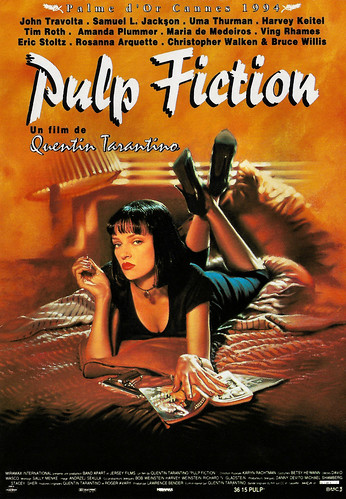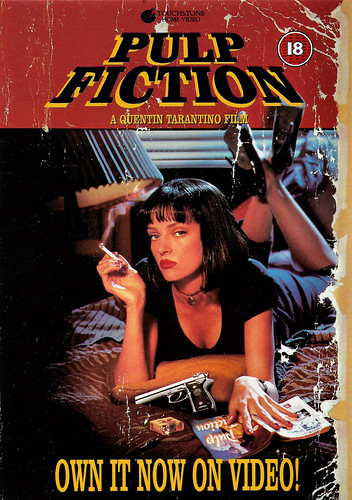
British postcard by Memory Card, no. 78. Samuel Jackson, John Travolta, Bruce Willis, and Uma Thurman in Pulp Fiction (Quentin Tarantino, 1994). Caption: lobby card.

French postcard by Sonis, no. C. 492. Photo: Bac Films. Uma Thurman on the French poster for Pulp Fiction (Quentin Tarantino, 1994). Caption: Affiche du film.

French postcard, no. C 583. John Travolta in Pulp Fiction (Quentin Tarantino, 1994).
The Dutch use mayonnaise with the chips
Quentin Tarantino wrote part of the screenplay for Pulp Fiction (1994) during a stay in Europe and the film is full of amusing observations about the French and Dutch lifestyle.
The nuisances towards Paris concern the French name of some McDonalds' products. To the great amusement of fellow gangster Jules Winnfield (Samuel Jackson), Vincent Vega (John Travolta), who has just returned from Europe, tells us that a "quarter-pounder with cheese" in Paris is sold as "royale with cheese" and that it is called "le big mac".
Vega has considerably more to say about life in Amsterdam: he praises the drug policy, the quality of the heroin, and the fact that beer is served in the cinema in the Netherlands.
When he tells Jules that instead of ketchup the Dutch use mayonnaise with the chips, they both have a dirty face. Such a thing is simply not possible :).

Vintage postcard, no. 2102. John Travolta and Uma Thurman in Pulp Fiction (Quentin Tarantino, 1994). Caption: John n Uma at table.

British postcard by Pyramid Posters, Leicester, no. PC9577. Photo: Miramax Film Corp. John Travolta and Samuel Jackson in Pulp Fiction (Quentin Tarantino, 1994). Caption: Guns B&W.

British postcard, no. MM 389. Photo: John Travolta in Pulp Fiction (Quentin Tarantino, 1994).
The staff consists of Marilyn Monroe, Mamie van Doren, Buddy Holly, and James Dean
The characters in Pulp Fiction (1994) have a lot to tell each other and their dialogues are snappy and fascinating. Tarantino uses a fragmentary structure and puts the different storylines cleverly together.
The result is an exciting, amusing, and at times extremely violent film that lingers long after you have left the cinema. The film title refers to the cheap crime novels that once formed the starting point for Film Noir.
The three stories put together by Tarantino are therefore closely related to the plots of countless American B movies from the 1940s and 1950s. At the beginning of the film, we are introduced to an enamored criminal couple (Amanda Plummer and Tim Roth) who decide to raid restaurants from now on, because liquor stores are no longer a lucrative target.
Elsewhere in town, gangsters Vincent and Jules pay an unexpected visit to some boys who have stolen a suitcase from gangster boss Marsellus Wallace (Ving Rhames). The contents of the case remain a mystery, but when the lid opens, light shines out, as in the classic Film Noir Kiss Me Deadly (Robert Aldrich, 1955).
Vincent is later ordered to take his boss's wife (Uma Thurman) out for a night. Dazed by a shot of heroin, he takes her to the trendy fifties bar Jack Rabbit Slims, where the staff consists of Marilyn Monroe, Mamie van Doren, Buddy Holly, and James Dean.
And then there's the story of boxer Butch Coolidge (Bruce Willis), who is bribed by Marsellus Wallace to go down in the fifth round of a major match.

British postcard, no. C075. Harvey Keitel in Pulp Fiction (Quentin Tarantino, 1994). Caption: The Wolf: "I don't smile in pictures."

British postcard, no. C076. Uma Thurman in Pulp Fiction (Quentin Tarantino, 1994). Caption: The Big-Man's Wife: "I can keep a secret if you can."

British postcard, no. C077. John Travolta in Pulp Fiction (Quentin Tarantino, 1994). The Hitman: "You play with matches, you get burned."
The Weinsteins hit the beach like commandos
Pulp Fiction's dialogues, music, and art direction constantly refer to American pop culture. Gangster Jules seems to have stepped out of a blaxploitation movie from the 1970s and regularly refers to TV series from the time.
All characters have their origins in classic archetypes from pulp novels and B movies and trump each other in hip language. Tarantino, who plays a supporting role himself, is surrounded by an impressive group of actors, also including Christopher Walken, Harvey Keitel, Eric Stoltz, Maria de Medeiros, and Rosanna Arquette.
John Travolta plays the role of his life as gangster Vincent Vega. His one-twos with Samuel Jackson and his stoned facial expressions are among the highlights of the film.
In the last part of the film, Tarantino treats the viewer to a nerve-racking orgy of violence. After some scenes, it looks like a new film is about to start and yet everything fits exactly. The result is a breathtaking film.
Pulp Fiction premiered in May 1994 at the Cannes Film Festival. The Weinsteins "hit the beach like commandos", bringing the picture's entire cast over. The film was unveiled at a midnight hour screening and caused a sensation. It won the Palme d'Or, the festival's top prize, generating a further wave of publicity. And Quentin Tarantino and Roger Avary were later awarded an Oscar for their script.
Against its budget of $8.5 million and about $10 million in marketing costs, Pulp Fiction wound up grossing $107.93 million at the U.S. box office, making it the first "indie" film to surpass $100 million. Worldwide, it took in nearly $213 million.

American postcard by Buena Vista Pictures Distribution. Photo: Touchstone Home Video. Bruce Willis in Pulp Fiction (Quentin Tarantino, 1994). Caption: "He was dead before he ever stepped into the ring." The Boxer.

British postcard. Image: Touchstone Home Video. Uma Thurman on the British poster for the video release of Pulp Fiction (Quentin Tarantino, 1994). Caption: Own it now on video!
Sources: Bart van der Put (De Filmkrant - Dutch), VPRO Cinema (Dutch), Wikipedia, and IMDb.
No comments:
Post a Comment